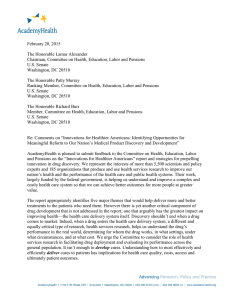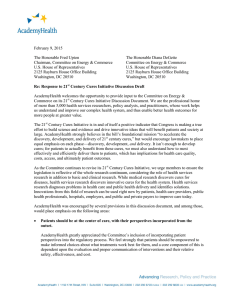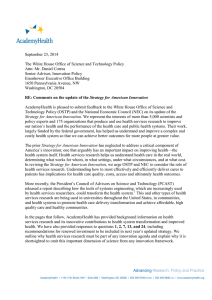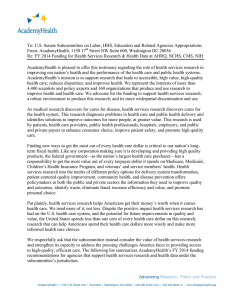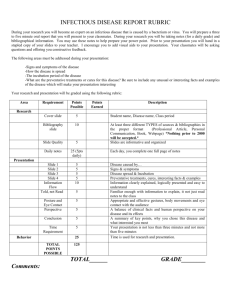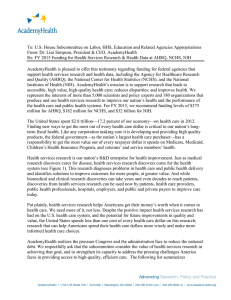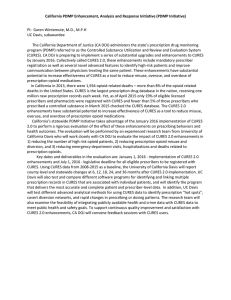June 5, 2014 The Honorable Fred Upton The Honorable Diana DeGette
advertisement
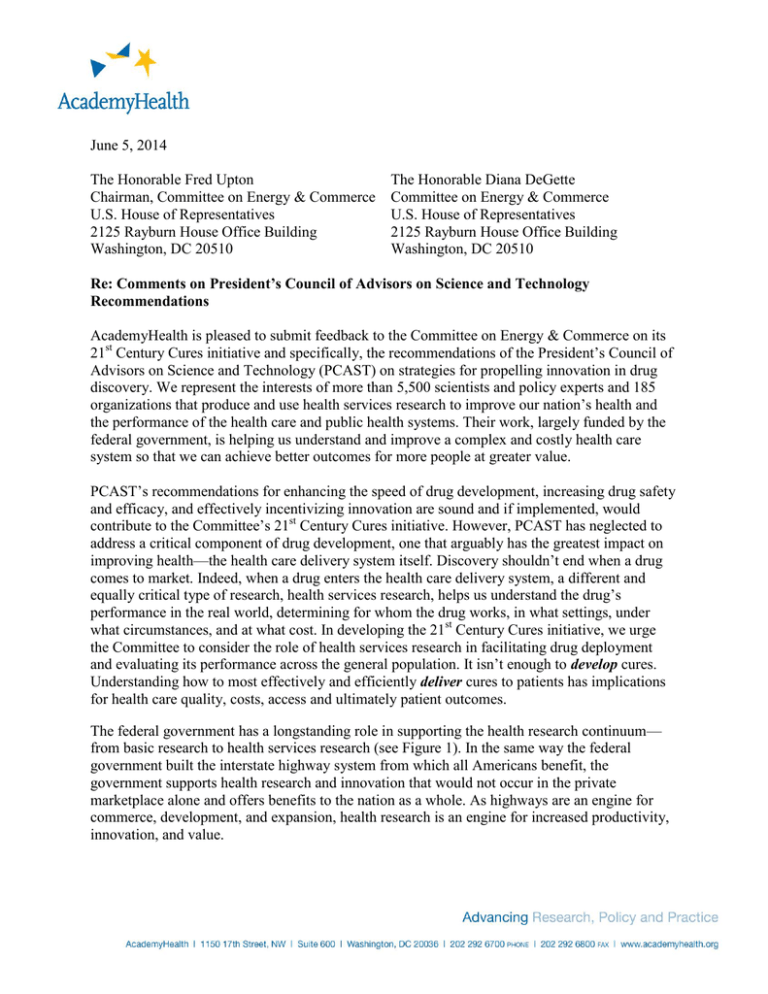
June 5, 2014 The Honorable Fred Upton Chairman, Committee on Energy & Commerce U.S. House of Representatives 2125 Rayburn House Office Building Washington, DC 20510 The Honorable Diana DeGette Committee on Energy & Commerce U.S. House of Representatives 2125 Rayburn House Office Building Washington, DC 20510 Re: Comments on President’s Council of Advisors on Science and Technology Recommendations AcademyHealth is pleased to submit feedback to the Committee on Energy & Commerce on its 21st Century Cures initiative and specifically, the recommendations of the President’s Council of Advisors on Science and Technology (PCAST) on strategies for propelling innovation in drug discovery. We represent the interests of more than 5,500 scientists and policy experts and 185 organizations that produce and use health services research to improve our nation’s health and the performance of the health care and public health systems. Their work, largely funded by the federal government, is helping us understand and improve a complex and costly health care system so that we can achieve better outcomes for more people at greater value. PCAST’s recommendations for enhancing the speed of drug development, increasing drug safety and efficacy, and effectively incentivizing innovation are sound and if implemented, would contribute to the Committee’s 21st Century Cures initiative. However, PCAST has neglected to address a critical component of drug development, one that arguably has the greatest impact on improving health—the health care delivery system itself. Discovery shouldn’t end when a drug comes to market. Indeed, when a drug enters the health care delivery system, a different and equally critical type of research, health services research, helps us understand the drug’s performance in the real world, determining for whom the drug works, in what settings, under what circumstances, and at what cost. In developing the 21st Century Cures initiative, we urge the Committee to consider the role of health services research in facilitating drug deployment and evaluating its performance across the general population. It isn’t enough to develop cures. Understanding how to most effectively and efficiently deliver cures to patients has implications for health care quality, costs, access and ultimately patient outcomes. The federal government has a longstanding role in supporting the health research continuum— from basic research to health services research (see Figure 1). In the same way the federal government built the interstate highway system from which all Americans benefit, the government supports health research and innovation that would not occur in the private marketplace alone and offers benefits to the nation as a whole. As highways are an engine for commerce, development, and expansion, health research is an engine for increased productivity, innovation, and value. Figure 1: The Health Research Continuum These components of the health research continuum work in concert, and each plays an essential role—any one type of research on its own cannot effectively or appreciably improve health. Take heart disease as one example… Basic research discovered the contributions of elevated blood pressure, elevated cholesterol, and tobacco use to heart disease. Clinical research Population-based Health services determined which research identified research determined treatments were safe strategies to reduce the how to best deploy these and effective to treat risks of heart disease in discoveries to achieve hypertension, communities through the best health hypercholesterolemia, non-medical outcomes. This research tobacco addiction, and interventions, such as helped identify who had to prevent and treat reduction of trans fats in the least access, what barriers existed, and heart disease, in general. food and tobacco control measures to innovative strategies to reduce smoking. mitigate them. This research also led to new quality measures that are now used to report on the quality of cardiac care. Source: AHRQ: 15 Years of Transforming Care and Improving Health, AcademyHealth, Jan. 2014. Available at: http://academyhealth.org/files/AHRQReport2014.pdf The United States spent $2.8 trillion—17.2 percent of our economy—on health care in 2012. Health services research has shown we waste as much as 30 percent of what we spend on health care on unnecessary services, inefficiently delivered services, and missed opportunities for prevention.i Finding new ways to get the most out of every health care dollar is critical to our nation’s long-term fiscal health, and health services research is our nation’s research and development, or ‘R&D,’ enterprise for such innovations. While medical research discovers cures for diseases, health services research discovers innovative cures for the health system. This research diagnoses problems in health care and public health delivery and identifies solutions (see Figure 2). Innovations from health services research can be used right now by patients, health care providers, public health professionals, hospitals, employers, and public and private payers to improve care today. Figure 2: Contributions of Health Services Research to Quality Improvement Thanks to health services research, we know that health care sometimes falls short… An estimated 1.7 million hospital-acquired infections occur each year, leading to about 100,000 deaths. Patients do not receive the care recommended for them by evidence. For example, patients with diabetes receive recommended preventive care only 21 percent of the time. Health care is increasingly complex and for patients with multiple chronic conditions, poor coordination results in unnecessary tests, hospitalization, and readmissions. One study found that almost one-fifth of Medicare patients were re-hospitalized within 30 days. Thanks to health services research, we know that falling short costs money… In 2008, costs attributable to medical errors were estimated at $19.5 billion—more than half of the National Institutes of Health’s annual budget. Medication errors alone cost as much as $2 billion each year—equivalent to the federal annual investment in health services research. The average cost of care for a patient with a catheter-related blood stream infection is $45,000, costing up to $2.3 billion annually nationwide. Medicare spends $12 billion a year on preventable hospital readmissions—more than double the discretionary budget of the Centers for Disease Control and Prevention. Thanks to health services research, we have identified innovations that work… Systematic reviews of adverse events have been instrumental in improving health care safety and the well-being of patients. For example, a report documenting the adverse events related to ephedra was instrumental in the withdrawal of the substance after a well-known baseball player died after using it. Another report documented the potential harmful side effects of atypical antipsychotics in the elderly, which led to a new FDA black box warning. Implementation of computerized physician order entry could prevent between 570,000 and 907,000 serious medication errors each year. Quality improvement approaches, including improved primary care, discharge planning, and follow-up care can prevent or reduce hospitalizations and rehospitalizations. Federal investments in the Agency for Healthcare Research and Quality (AHRQ)—the federal agency with the sole purpose of supporting health services research—has created a wealth of knowledge about our health care delivery system. For example, Dr. David Penson of Vanderbilt University Medical Center used funding from AHRQ not to find the newest drug for the treatment of prostate cancer, but to maximize outcomes using the treatments already available and to get information about what works to patients and providers so they can make better decisions. His focus on innovation is to bring health services research to the frontiers of personalized health decision-making in cancer treatment, where a patient can go to a website, type in demographic data, and see the likely outcomes for a range of treatments for their demographic. Such innovative tools will allow for patients to participate as informed parties in their health care decisions. During his tenure as Executive Vice president and Chief of Medical Affairs for UnitedHealth Group, Dr. Reed Tuckson used health services research to make America’s largest health company an industry leader in care improvement. One “extremely important” tool in Dr. Tuckson’s evidence arsenal was AHRQ’s Guide to Clinical Preventive Services. The guide summarizes evidence-based recommendations on the performance of medications, screening, and counseling developed by the U.S. Preventive Services Task Force—an independent, nongovernmental panel of primary care providers. The guide informs health care practitioners’ and other stakeholders about existing evidence about what treatments work for whom, and is a critical resource for health plans such as UnitedHealth Group. “One of the unfortunate realities of science is that answers are not often black or white, but are made up of nuances and subtleties,” said Dr. Tuckson. “The Guide provides a legitimate, trustworthy, and thoughtful scientific forum to evaluate evidence so that others can use it to make fundamental decisions that affect the health of millions of people.” Even with more, better, and faster drug discoveries, these innovations will fall short of their potential if we don’t determine how to best deploy them to physicians and patients. Put plainly, health services research helps maximize the return on investment in basic and clinical research, ensuring that patients have access to and truly benefit from drug discoveries and medical advances. We look forward to working with the Committee to determine how to best to better integrate health services research into the 21st Century Cures initiative, and move biomedical discoveries from the bench, to the bedside, to the curbside and beyond. If you have questions about these comments, please don’t hesitate to contact Dr. Lisa Simpson, President & CEO of AcademyHealth, at 202.292.6747 or lisa.simpson@academyhealth.org. i Institute of Medicine, Best Care at Lower Cost: The Path to Continuously Learning Health Care in America. September 2012. www.iom.edu/Reports/2012/Best-Care-at-Lower-Cost-The-Path-to-Continuously-LearningHealth-Care-in-America.aspx
